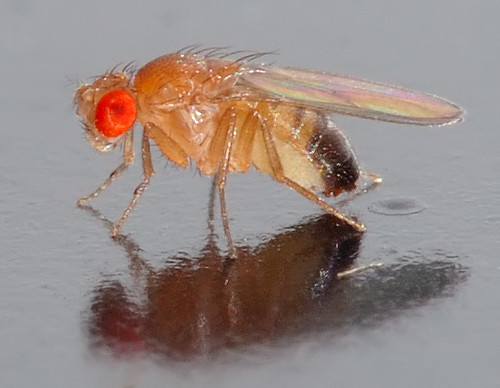
Drosophila Melanogaster
Drosophila was first used as a model organism by Thomas Morgan in the early 1900s. He used the Drosophila to study genetics and showed that genes were arranged on chromosomes in a linear array.
Since then our knowledge of the Drosophila, and its usefulness as a model organism has increased dramatically as new techniques have been developed.

The recent sequencing of the genome of both the Fruit Fly and the Human has shown the vast similarities between the two genomes and highlights the conservation that occurs through evolution. Of the 298 genes found to be involved in human disease, so far 177 of them have also been found in the Drosophila.
"We are much more like flies in our development than you might think" - Lewis Wolpert
Advantages of the Fruit Fly as a model organism:
- Short life cycle – develops into adult fly 9 days after fertilisation.
- Genome sequenced – 13600 protein coding genes have been predicted from this sequence.
- Cheap and easy to look after and reproduce.
- Mutant flies easily crossed, and the results have been shown to be transferable to humans.
- Large batches of embryos.
- Detailed cytological and genetic map.
Disadvantages of the Fruit Fly as a model organism:
- Small embryo.
- Non-mammalian invertebrate model, so some discoveries cannot be directly transferred across to apply to the human system.
What is the fly used as a model organism for?
- Developmental studies.
- Mutagenesis.
- Transgenetics.
- Clonal Analysis.
Classic Experiment:
Maternal mutations: Bicoid mutant – missing head end.
Nanos mutant – missing posterior abdomen.
Torso mutant – missing head and tail end.
This therefore allowed scientists to conclude that these genes were involved in segmentation.
Drosophila are great models for studying development:
Axis formation, through studying maternal genes, gap genes, pair rule genes and segment polarity genes. Also a great organism for studying the Hox genes – expressed along AP axis in the same order that they occur in the genome.
Leg and wing formation – Imaginal discs. Experiments showed that the patterning mechanisms used to develop the drosophila leg is broadly conserved in vertebrates, using vertebrate gene homologs.
Drosophila in Medical Research:
Aniridia: Pax 6 or eyeless mutations were studied in Drosophila. Mutations in this gene are responsible for the human condition Aniridia. Experiments mis-expressing human Pax 6 in flies Showed that Pax 6 is necessary and sufficient to form an eye.
Alzheimers: Drosophila have recently been used for models in Alzheimers disease because they have highly developed muscles and nerves in contrast to their simple brains.
References:
https://genome.wellcome.ac.uk/doc_WTD023552.html
Principles of Development 3rd edition - Lewis Wolpert
https://www.animalresearch.info/en/science/animalsused/drosophila
Drosophila Image courtesy of flickr under the creative commons license.